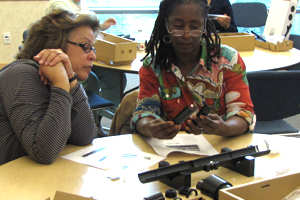 Oakland Unified teachers assembling Galileoscopes at ChabotWhat was it like for Galileo, the first time he put an eye to his telescope to see things in the heavens as never before seen? As anyone who has seen a planet or a star cluster or a nebula—or the Moon—through even a small telescope knows, the sight can be quite breathtaking. For Galileo, it must have been a universe-changing experience….
Oakland Unified teachers assembling Galileoscopes at ChabotWhat was it like for Galileo, the first time he put an eye to his telescope to see things in the heavens as never before seen? As anyone who has seen a planet or a star cluster or a nebula—or the Moon—through even a small telescope knows, the sight can be quite breathtaking. For Galileo, it must have been a universe-changing experience….
Through a generous donation by a concerned citizen (concerned that kids today aren't seeing enough of the sky), Chabot just completed a pair of workshops for Oakland teachers that places in their capable hands and in their classrooms "Galileoscopes"—special telescopes designed and manufactured for the 2009 International Year of Astronomy. The Galileoscope is a low cost, simple, but good-quality telescope designed to simulate the power and field of view of Galileo's original telescope, which opened up the universe in such a profound way.
In September and October, a total of 23 Oakland teachers received training, activities, and one Galileoscope each (plus tripod), enabling them to share the experience with their students and, hopefully, spark their imagination and curiosity about the world around us in a way that nothing but astronomy does.
A look through a telescope—any telescope, big or small—does put a spark in the eye and the imagination. At least, that was my experience. Growing up in Oakland back in the 60's, I didn't have access to any small telescopes, but Chabot Observatory was only a couple miles away, and my family often went up on a weekend night for a classroom demo, a planetarium show, and thoroughly enjoyable viewing through the two antique telescopes, Leah and Rachel. Something about the actual light from Saturn or Jupiter or a distant galaxy tickling the receptors in your retina places you out there—or puts those objects directly into your brain.
The Oakland teachers now armed with their Galileoscopes will use these simple but effective tools to show their students the difference between seeing Saturn as a spot of light and Saturn as a disk with "ears" (the appearance of its rings through a Galileoscope), or the difference between Jupiter as a brighter spot of light and Jupiter as a world with a giant storm in its clouds and four smaller "worlds" (moons) in orbit around it, or the difference between the Moon as a disk with light and dark areas that make interesting shapes in our imaginations and the Moon with mountain ranges, vast plains, thousands upon thousands of craters, and shadows stretching across the landscape.
